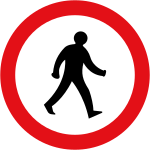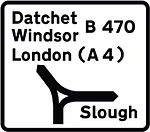1. Introductory
|
Quick recognition of different groups of signs is aided by the use of different shapes and colours |
1.1 Clear and efficient signing is an essential part of highway and traffic engineering and a road with poor signing or with badly maintained signs is an unsatisfactory road. Road users depend on signing for information and guidance; highway authorities depend on signing for the efficient working and the enforcement of traffic regulations, for traffic control, and as an aid to road safety. Signing includes not only signs on posts but also carriageway markings, beacons, studs, bollards, traffic signals and other devices.
1.2 Signs must give road users their message clearly and at the correct time. The message must be unambiguous and speedily understood; it must be given not too soon for the information to have been forgotten before it is needed, and not too late for the safe performance of consequent manoeuvres. 1.3 The types of signs and carriageway markings etc, available for use are prescribed by Regulations. Limiting the number of types of sign available assists in their quick recognition as does uniformity of shape, colour and lettering for each type. It also makes available to highway authorities a set of standard signs and saves them the labour of design. It aids the courts in giving the same meaning to standard signs. Quick recognition is further aided by using different shapes and colours for different sign groups, e.g., warning signs are triangular with black symbols, white grounds and red borders. 1.4 Uniformity of signs is not however enough; uniformity of signs without uniformity in use is objectionable and could impair road safety. For instance, warning signs sited at different distances from their hazards in different districts could confuse a road user accustomed to only one district. 1.5 To obtain the fullest benefits of uniformity there must not only be uniformity of signs but also uniformity in their use, in their siting and their illumination. 1.6 This manual sets out the codes to be followed in the use, siting, and illumination of signs both on all-purpose roads and motorways. It also covers temporary signs for use in connection with road works, in emergency by the police, and temporary route signing by motoring organisations and highway authorities. 1.7 In this chapter, after historical and legal sections, there follow sections describing the basic technical requirements of the present signing system. Most of these technical sections are expanded in greater detail in later chapters. |




